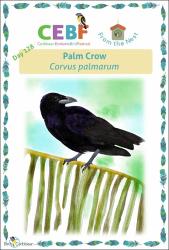| Abstract | Caribbean Endemic Bird Festival (CEBF) day 128 poster, dedicated to the Palm Crow. A crow that lives on palm trees? Well, yes…, but the name can be misleading. Palm Crow (Corvus palmarum) can also be found in high-elevation pine forests, lowland and swampy forests, dry plains, and cultivation areas. Restricted to the islands of Cuba and Hispaniola, there is a recent proposal for separating them into two different species. This could have a profound effect on its conservation status, given that the Cuban subspecies is very rare and confined to just a few localities. This bird is one of the four resident species of crows in the Caribbean. All of them show the classic black plumage with purple-blue iridescence, that people associate with crows and their spooky reputation. They are gregarious, often found in small flocks. Cuban Crow and Palm Crow are almost indistinguishable, a fact that poses an identification challenge for every birder. Fortunately, they have unique vocalizations. The song of the Palm Crow is a harsh nasal “craaa, craaa,” that resembles the North American Fish Crow (Corvus ossifragus), while the song of the Cuban Crow resembles parrot calls or a gobbling turkey. The Palm Crow also has the well-developed nasal bristles covering nostrils that distinguishes crows from other small blackbirds. The Cuban subspecies is slightly smaller and duller than the one living in Hispaniola. The Palm Crow’s short, stout, sharp-pointed black bill allows it to devour a variety of food items from fruits to invertebrates. Another important clue for identifying this species is that it can be found frequently feeding on the ground, sometimes near roads, contrasting with its other Caribbean relatives that rarely leave the tree tops. As a complement to the poster, a coloring sheet is included. | es |



